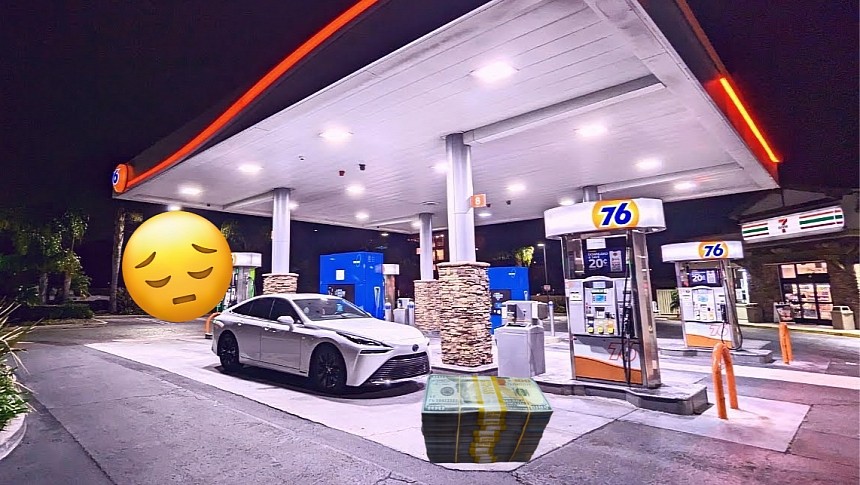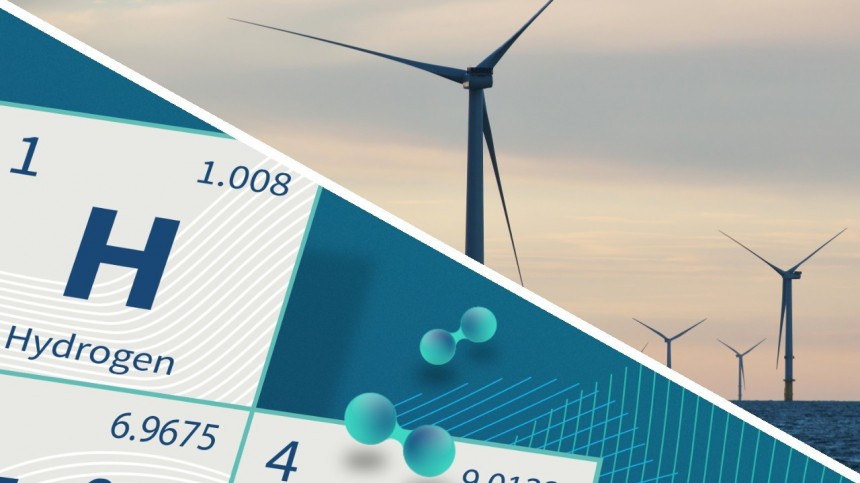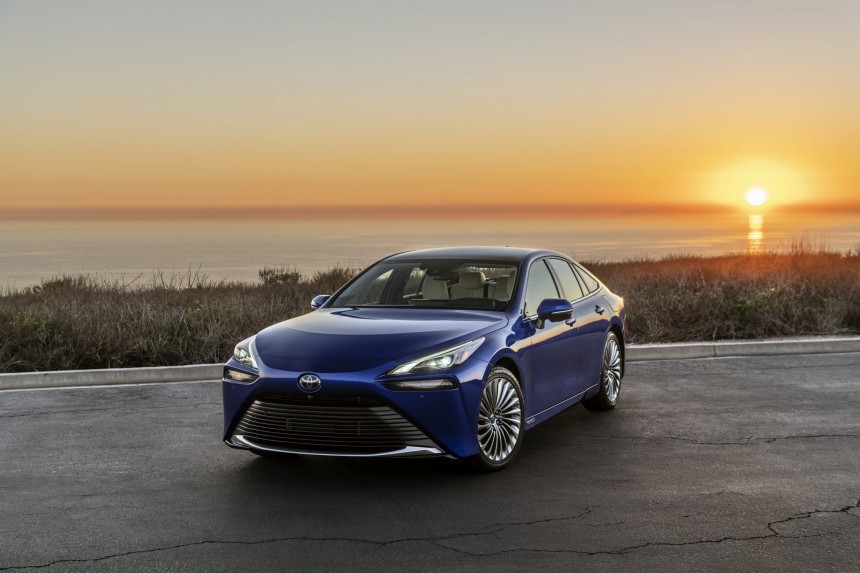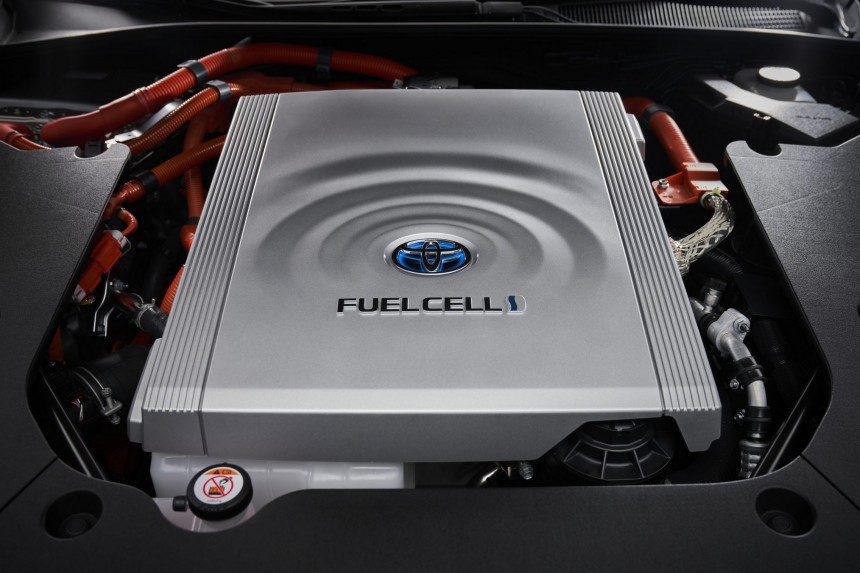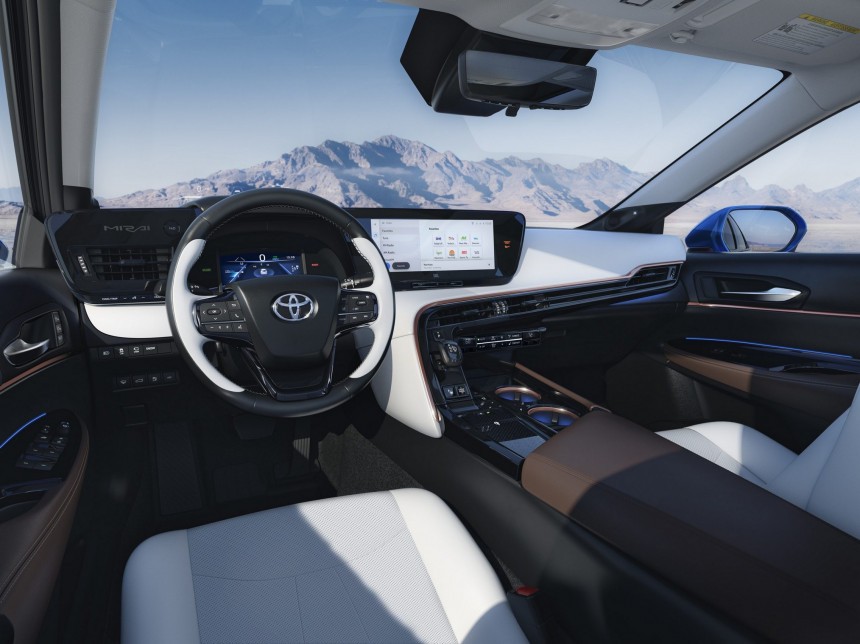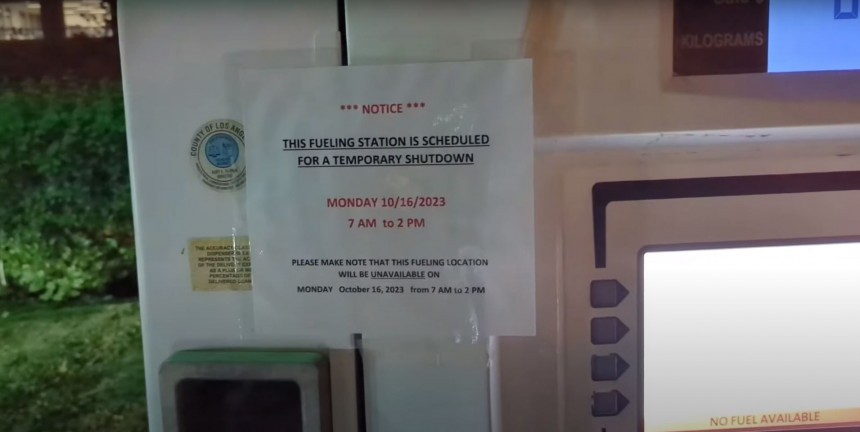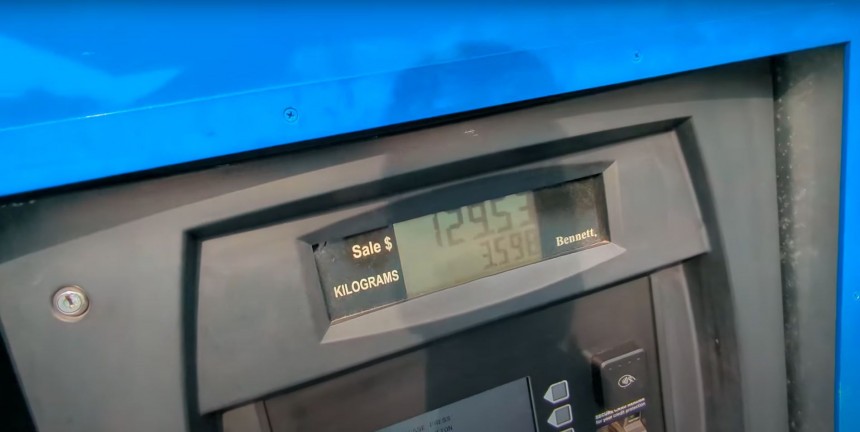A hydrogen-powered car like the Toyota Mirai promises to offer customers an ownership experience similar to conventional vehicles. Low on fuel? Just go to the hydrogen station. Fill up the tank in a few minutes, and continue your journey. There's one issue, though: convenience and sustainability don't mix well in the automotive world. It'll cost you.
Automakers are trying to find the ideal powertrains that will make us forget about controlled explosions happening under the hood of our vehicles. Besides battery-electric vehicles, we also have fuel-cell cars. The latter comprises one or more high-pressure fuel tanks, a fuel cell stack, at least one motor, a battery, and an exhaust.
The hydrogen is sent from the fuel tank to the fuel cell stack, where it is combined with oxygen and transformed into electrical energy. The result? A few droplets of water.
Hydrogen is the most abundant element in the universe. Weirdly enough, today's cheapest hydrogen is not as green as you might think. It's obtained from natural gas, which is a fossil fuel. It's known as grey hydrogen because steam reforming (which happens at temperatures of 1,292 degrees Fahrenheit minimum) doesn't capture the carbon emissions created during the process. But experts claim this is the most energy-efficient way to make it, so there's that.
Ideally, what we should use is green hydrogen because it's obtained through electrolysis of water. The electricity that zaps apart the hydrogen and oxygen molecules comes from renewable sources such as wind, solar, or hydro.
But we must deal with the grey stuff until Earth's greatest minds figure out a way to make green hydrogen profitable and cheap.
Even if automakers could somehow manufacture zero-emission cars with no production carbon footprint, we would still have to worry about tire particles, brake dust, and electricity sources.
Thus, the best thing we can do is eliminate our dependence on oil derivatives. Giving up on gasoline, diesel, kerosene, compressed natural gas, and liquified petroleum gas would work wonders for our planet. But even that is complicated because it should be an international effort. It won't mean much if North America and Europe step up and Asia or Africa don't follow suit.
However, some nations and corporations are taking many steps in the right direction. The US is a good example in this regard. It supports the transition to battery-electric vehicles through subsidies and incentives but also spends good money on alternative solutions like fuel-cell cars.
The latter aren't very powerful. The rear-wheel-drive Mirai, for example, has an output of 182 hp and 300 lb-ft of torque. That's not impressive at all in this day and age. But those are enough ponies for a commuting appliance that doesn't strain the local environment.
The Mirai also has a 1.2-kWh high-voltage Li-ion battery that weighs 98.3 lb. Its role is vital to keep drivers happy. The fuel-cell system runs at an ideal rate and cannot overclock itself to add more horses to the herd. So, the small battery kicks in when the one sitting behind the steering wheel wants to pass someone on the highway.
BMW borrowed this technology from Toyota but couldn't make a similarly bland vehicle. As such, the iX5 became sort of a battery-hydrogen-electric hybrid. The fuel cell delivers 168 hp of continuous output, while the high-voltage battery fully (and temporarily!) unlocks the motor's performance. The fuel-cell stack and the high-voltage energy storage unit allow the iX5 to play with 396 well-trained and very clean ponies.
Those are just a few reasons why automakers continue to invest in diversifying their lineups. They could strike gold!
But for people like you and me, there's one thing about these hydrogen-powered drivetrains we might find attractive – they break with tradition. They're new, cool, and intriguing. In a way, they're like the Cybertruck. You might be tempted to try it just because it's different from everything else on the road.
Some Californians stopped wishing and acted. They wanted to discover this alternative. So, they embraced the early adopter lifestyle. What they didn't know was that novelty can sometimes cost – a lot.
When writing, the 2023 Toyota Mirai has an MSRP of $49,500. That'll get you the XLE trim. The $66,000 Mirai Limited is your pick if you want more equipment. The former goes 402 miles on a full tank, while the latter runs 357 miles. More options equals more weight. More weight equals more mass to haul around. You get the picture.
But no matter the budget, you won't be able to get an all-wheel-drive unit. Both cars send power to the rear wheels only. Moreover, you have to be in California to buy one. Toyota won't sell the Mirai in any other state for now. Most of the hydrogen stations are in the Golden State, anyway.
A quick look at the price tag shows us that finding Mirai customers is going to be a challenge. The soon-to-be-refreshed single-motor Model 3 has an MSRP of around $39,000. Would you pay $10,500 more for a zero-emission Toyota that's only 10 inches longer and can't be charged at home? You might!
Mirai owners say the sedan rides like a Lexus and feels like an extra premium car. But is that enough to convince you? Probably not. So, here's what Toyota can do for you to sweeten the deal.
Now that the state and federal incentives are gone, the Japanese automaker gives early adopters who finance or lease a Mirai by the end of March 2024:
That's not enough? Well, you'll be glad to find out that the automaker also has some very convincing incentives like 0% APR for 72 months and $30,000 off the final price if you have excellent credit and finance through Toyota. That results in a car note of about $500 for a Mirai Limited with no downpayment.
If you're not ready for that type of commitment, Toyota invites prospective customers to lease a Mirai XLE for 36 months. You'll need $5,000 at signing. After that, the monthly payment will be $709 per month.
The abovementioned offers are good until February 1, 2024. Don't wait too long if you qualify and want to start the new year with a challenge that might allow you to explore a niche drivetrain solution.
On top of that, hydrogen stations sometimes simply shut down. Last year, there was even a shortage in some parts of the Golden State. Imagine being unable to fill up with gas or recharge your EV for about three weeks. It would wreck the economy. It would make our lives hell.
That's not an impossible scenario or a one-time thing that happened and is now behind us. As I type these words, nine hydrogen stations in southern California are offline.
Then, there's filling up with the right stuff (H70). If you don't pay attention to the button you're pressing, you might end up with H35 being pushed into your Mirai's tank or, better said, tanks. This Toyota has three!
H70 is packaged at 10,000 psi and dispensed at -40 degrees Celsius. H35 sits at half the pressure and doesn't require any extra cooling. Pick the latter to fill your vehicle's tanks up, and you're only going half the maximum possible distance.
However, a trip from Santa Barbara to San Jose (280 miles) would cut it pretty close even when using H70. Owners report a real-world range that varies between 260 and 290 miles, despite Toyota saying that the Mirai can cover 402 miles on a full tank.
Then, there's the cost - $36 per kilogram ($136 per gallon). That can scare anyone, including battery-electric vehicle owners. That's why that fuel card is essential.
For example, a kilogram of hydrogen in Germany can be three times cheaper. Thus, it's unsurprising that the country's most well-known auto brands are fighting to make fuel-cell vehicles and trucks a thing.
But given that perks like a free tow truck or rental and a fuel card are guaranteed no matter what buying option you pick, Californians could comfortably have some fun with the Mirai. They just can't leave the state or travel too far from a live hydrogen station. At least they are shown in the infotainment!
When the first few hydrogen stations opened with federal, state, local, and private support, Toyota, Honda, and Hyundai confidently agreed that other brands would follow with models of their own "within the next few years." I think they were a bit too optimistic.
But that doesn't mean hydrogen can't play a role in our transition toward sustainable drivetrains. We shouldn't sound the death knell – yet.
The hydrogen is sent from the fuel tank to the fuel cell stack, where it is combined with oxygen and transformed into electrical energy. The result? A few droplets of water.
Hydrogen is the most abundant element in the universe. Weirdly enough, today's cheapest hydrogen is not as green as you might think. It's obtained from natural gas, which is a fossil fuel. It's known as grey hydrogen because steam reforming (which happens at temperatures of 1,292 degrees Fahrenheit minimum) doesn't capture the carbon emissions created during the process. But experts claim this is the most energy-efficient way to make it, so there's that.
Ideally, what we should use is green hydrogen because it's obtained through electrolysis of water. The electricity that zaps apart the hydrogen and oxygen molecules comes from renewable sources such as wind, solar, or hydro.
A glass half-full
It's not as bad as it may sound. High-voltage batteries and motors used in EVs like the Tesla Model S or the Fisker Ocean require mining for important metals, and that's a very carbon-intensive activity. Nothing's as clean as we may want it to be.Even if automakers could somehow manufacture zero-emission cars with no production carbon footprint, we would still have to worry about tire particles, brake dust, and electricity sources.
Thus, the best thing we can do is eliminate our dependence on oil derivatives. Giving up on gasoline, diesel, kerosene, compressed natural gas, and liquified petroleum gas would work wonders for our planet. But even that is complicated because it should be an international effort. It won't mean much if North America and Europe step up and Asia or Africa don't follow suit.
However, some nations and corporations are taking many steps in the right direction. The US is a good example in this regard. It supports the transition to battery-electric vehicles through subsidies and incentives but also spends good money on alternative solutions like fuel-cell cars.
The Mirai also has a 1.2-kWh high-voltage Li-ion battery that weighs 98.3 lb. Its role is vital to keep drivers happy. The fuel-cell system runs at an ideal rate and cannot overclock itself to add more horses to the herd. So, the small battery kicks in when the one sitting behind the steering wheel wants to pass someone on the highway.
BMW borrowed this technology from Toyota but couldn't make a similarly bland vehicle. As such, the iX5 became sort of a battery-hydrogen-electric hybrid. The fuel cell delivers 168 hp of continuous output, while the high-voltage battery fully (and temporarily!) unlocks the motor's performance. The fuel-cell stack and the high-voltage energy storage unit allow the iX5 to play with 396 well-trained and very clean ponies.
Innovating in America, with Americans, for everybody
By now, you might believe that hydrogen-powered vehicles are a gimmick or too complicated. It can definitely seem like that at first, but there's more to them. Models like the Toyota Mirai or BMW iX5 can tap the advantages of hydrogen abundance. They're also lighter. So, tires aren't too stressed and don't have to be made of a special low-resistance compound. That's the type of footwear models like the bZ4X or the i7 need.Those are just a few reasons why automakers continue to invest in diversifying their lineups. They could strike gold!
Some Californians stopped wishing and acted. They wanted to discover this alternative. So, they embraced the early adopter lifestyle. What they didn't know was that novelty can sometimes cost – a lot.
When writing, the 2023 Toyota Mirai has an MSRP of $49,500. That'll get you the XLE trim. The $66,000 Mirai Limited is your pick if you want more equipment. The former goes 402 miles on a full tank, while the latter runs 357 miles. More options equals more weight. More weight equals more mass to haul around. You get the picture.
But no matter the budget, you won't be able to get an all-wheel-drive unit. Both cars send power to the rear wheels only. Moreover, you have to be in California to buy one. Toyota won't sell the Mirai in any other state for now. Most of the hydrogen stations are in the Golden State, anyway.
The numbers
The Mirai doesn't qualify for the revamped federal EV tax credit because it's imported from Japan (JDM, yeah!). California used to offer a tax rebate (not a credit!) of $4,500 ($7,500 if you were low-income). Sadly, that ship has sailed. The Clean Vehicle Rebate Project (CVRP) exhausted the funds in early September, and it's not receiving more money.Mirai owners say the sedan rides like a Lexus and feels like an extra premium car. But is that enough to convince you? Probably not. So, here's what Toyota can do for you to sweeten the deal.
Now that the state and federal incentives are gone, the Japanese automaker gives early adopters who finance or lease a Mirai by the end of March 2024:
- 24/7 customer support by phone;
- three years or 35,000 miles of extended ToyotaCare;
- eight years or 100,000 miles of warranty for the fuel cell stack;
- 10 years or 150,000 miles of warranty for the small high-voltage battery;
- roadside assistance with expedited towing and trip interruption reimbursement for three years with no mileage limit;
- complimentary rental vehicle for 21 days maximum during the first three years;
- a fuel card with $15,000 on it that's good for three years for lessees and six years for buyers.
That's not enough? Well, you'll be glad to find out that the automaker also has some very convincing incentives like 0% APR for 72 months and $30,000 off the final price if you have excellent credit and finance through Toyota. That results in a car note of about $500 for a Mirai Limited with no downpayment.
The abovementioned offers are good until February 1, 2024. Don't wait too long if you qualify and want to start the new year with a challenge that might allow you to explore a niche drivetrain solution.
The (obvious) downside(s)
Hydrogen. As abundant as it is and as easy as it can be to make it, companies have a hard time bringing the gas to car owners who are courageous enough to pull the trigger on such an interesting and promising drivetrain.On top of that, hydrogen stations sometimes simply shut down. Last year, there was even a shortage in some parts of the Golden State. Imagine being unable to fill up with gas or recharge your EV for about three weeks. It would wreck the economy. It would make our lives hell.
That's not an impossible scenario or a one-time thing that happened and is now behind us. As I type these words, nine hydrogen stations in southern California are offline.
H70 is packaged at 10,000 psi and dispensed at -40 degrees Celsius. H35 sits at half the pressure and doesn't require any extra cooling. Pick the latter to fill your vehicle's tanks up, and you're only going half the maximum possible distance.
However, a trip from Santa Barbara to San Jose (280 miles) would cut it pretty close even when using H70. Owners report a real-world range that varies between 260 and 290 miles, despite Toyota saying that the Mirai can cover 402 miles on a full tank.
Then, there's the cost - $36 per kilogram ($136 per gallon). That can scare anyone, including battery-electric vehicle owners. That's why that fuel card is essential.
But given that perks like a free tow truck or rental and a fuel card are guaranteed no matter what buying option you pick, Californians could comfortably have some fun with the Mirai. They just can't leave the state or travel too far from a live hydrogen station. At least they are shown in the infotainment!
When the first few hydrogen stations opened with federal, state, local, and private support, Toyota, Honda, and Hyundai confidently agreed that other brands would follow with models of their own "within the next few years." I think they were a bit too optimistic.
But that doesn't mean hydrogen can't play a role in our transition toward sustainable drivetrains. We shouldn't sound the death knell – yet.
